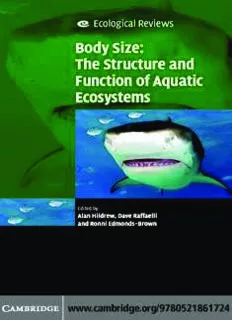Table Of ContentBodySize:TheStructureandFunctionofAquaticEcosystems
Ecologistshavelongstruggledtopredictfeaturesofecologicalsystems,suchas
thenumbersanddiversityoforganisms.Thewiderangeofbodysizesinecological
communities,fromtinymicrobestolargeanimalsandplants,isemergingasthe
keytoprediction.Basedontherelationshipofbodysizewithkeybiologicalrates
andwiththephysicalworldexperiencedbyaquaticorganisms,wemaybeableto
understandpatternsofabundanceanddiversity,biogeography,interactionsinfood
websandtheimpactoffishing,addinguptoapotential‘periodictable’forecology.
Remarkableprogressontheunravelling,describingandmodellingofaquaticfood
webs,revealingthefundamentalroleofbodysize,makesabookemphasizing
marineandfreshwaterecosystemsparticularlyapt.Here,theimportanceofbody
sizeisexaminedatarangeofscales,yieldingbroadperspectivesthatwillbeof
interesttoprofessionalecologists,fromstudentstoseniorresearchers.
ALAN G. HILDREW isProfessorofEcologyintheSchoolofBiologicaland
ChemicalSciencesatQueenMary,UniversityofLondon.
DAVID G. RAFFAELLI isProfessorofEnvironmentalScienceattheUniversityof
York.
RONNI EDMONDS-BROWN isaSeniorLecturerinEnvironmentalSciencesatthe
UniversityofHertfordshire.
Body Size
The Structure and Function
of Aquatic Ecosystems
Edited by
ALAN G. HILDREW
SchoolofBiologicalandChemicalSciences,QueenMary,UniversityofLondon,UK
DAVID G. RAFFAELLI
EnvironmentDepartment,UniversityofYork,UK
RONNI EDMONDS-BROWN
DivisionofGeographyandEnvironmentalSciences,UniversityofHertfordshire,UK
CAMBRIDGEUNIVERSITY PRESS
Cambridge, New York, Melbourne, Madrid, Cape Town, Singapore, São Paulo
Cambridge University Press
The Edinburgh Building, Cambridge CB2 8RU, UK
Published in the United States of America by Cambridge University Press, New York
www.cambridge.org
Information on this title: www.cambridge.org/9780521861724
© British Ecological Society 2007
This publication is in copyright. Subject to statutory exception and to the provision of
relevant collective licensing agreements, no reproduction of any part may take place
without the written permission of Cambridge University Press.
First published in print format 2007
ISBN-13 978-0-511-29587-4 eBook (MyiLibrary)
ISBN-10 0-511-29587-1 eBook (MyiLibrary)
ISBN-13 978-0-521-86172-4 hardback
ISBN-10 0-521-86172-1 hardback
ISBN-13 978-0-521-67967-1 paperback
ISBN-10 0-521-67967-2 paperback
Cambridge University Press has no responsibility for the persistence or accuracy of urls
for external or third-party internet websites referred to in this publication, and does not
guarantee that any content on such websites is, or will remain, accurate or appropriate.
Contents
Listofcontributors pagevii
Preface ix
1 Themetabolictheoryofecologyandtheroleofbodysizein
marineandfreshwaterecosystems
JamesH.Brown,AndrewP.AllenandJamesF.Gillooly 1
2 Bodysizeandsuspensionfeeding
StuartHumphries 16
3 Lifehistoriesandbodysize
DavidAtkinsonandAndrewG.Hirst 33
4 Relationshipbetweenbiomassturnoverandbodysizeforstream
communities
AlexanderD.HurynandArthurC.Benke 55
5 Bodysizeinstreams:macroinvertebratecommunitysize
compositionalongnaturalandhuman-inducedenvironmental
gradients
ColinR.TownsendandRossM.Thompson 77
6 Bodysizeandpredatoryinteractionsinfreshwaters:scalingfrom
individualstocommunities
GuyWoodwardandPhilipWarren 98
7 Bodysizeandtrophiccascadesinlakes
J.IwanJonesandErikJeppesen 118
8 Bodysizeandscaleinvariance:multifractalsin
invertebratecommunities
PeterE.SchmidandJennyM.Schmid-Araya 140
9 Bodysizeandbiogeography
B.J.FinlayandG.F.Esteban 167
10 Bywind,wingsorwater:bodysize,dispersaland
rangesizeinaquaticinvertebrates
SimonD.Rundle,DavidT.BiltonandAndrewFoggo 186
vi CONTENTS
11 Bodysizeanddiversityinmarinesystems
RichardM.Warwick 210
12 Interplaybetweenindividualgrowthandpopulationfeedbacks
shapesbody-sizedistributions
LennartPerssonandAndre´ M.DeRoos 225
13 Theconsequencesofbodysizeinmodelmicrobialecosystems
OwenL.Petchey,ZacharyT.LongandPeterJ.Morin 245
14 Bodysize,exploitationandconservationofmarineorganisms
SimonJenningsandJohnD.Reynolds 266
15 Howbodysizemediatestheroleofanimalsinnutrientcycling
inaquaticecosystems
RobertO.Hall,Jr.,BenjaminJ.Koch,MichaelC.Marshall,
BradW.TaylorandLushaM.Tronstad 286
16 Bodysizesinfoodchainsofanimalpredatorsandparasites
JoelE.Cohen 306
17 Bodysizeinaquaticecology:important,butnotthewholestory
AlanG.Hildrew,DavidG.RaffaelliandRonniEdmonds-Brown 326
Index 335
Contributors
AndrewP.Allen NationalCenterfor G.F.Esteban SchoolofBiologicaland
EcologicalAnalysisandSynthesis,Santa ChemicalSciences,QueenMary,University
Barbara,CA93101,USA. ofLondon,EastStoke,WarehamDorset
DavidAtkinson Populationand BH206BB,UK.
EvolutionaryBiologyResearchGroup, B.J.Finlay SchoolofBiologicaland
SchoolofBiologicalSciences,TheUniversity ChemicalSciences,QueenMary,University
ofLiverpool,BiosciencesBuilding,Crown ofLondon,EastStoke,WarehamDorset
Street,LiverpoolL697ZB,UK. BH206BB,UK.
ArthurC.Benke AquaticBiology AndrewFoggo MarineBiologyand
Program,Box870206,Departmentof EcologyResearchCentre,Universityof
BiologicalSciences,UniversityofAlabama, Plymouth,PlymouthPL48AA,UK.
Tuscaloosa,AL35487-0206,USA. JamesF.Gillooly Departmentof
DavidT.Bilton MarineBiologyand Zoology,UniversityofFlorida,Gainesville,
EcologyResearchCentre,Universityof FL32607,USA.
Plymouth,PlymouthPL48AA,UK. RobertO.Hall,Jr. Departmentof
JamesH.Brown DepartmentofBiology, ZoologyandPhysiology,Universityof
UniversityofNewMexico,Albuquerque, Wyoming,Laramie,WY82071,USA.
NM87131,USA. AlanG.Hildrew SchoolofBiological
JoelE.Cohen LaboratoryofPopulations, andChemicalSciences,QueenMary,
RockefellerandColumbiaUniversities, UniversityofLondon,
1230YorkAvenue,Box20,NewYork, LondonE14NS,UK.
NY10021-6399,USA. AndrewG.Hirst BritishAntarctic
Andre´ M.DeRoos Instituteof Survey,HighCross,MadingleyRoad,
BiodiversityandEcosystems,Universityof CambridgeCB30ET,UK.
Amsterdam,P.O.B.94084,NL-1090GB StuartHumphries Departmentof
Amsterdam,theNetherlands. AnimalandPlantSciences,University
RonniEdmonds-Brown Divisionof ofSheffield,WesternBank,SheffieldS10
GeographyandEnvironmentalSciences, 2TN,UK.
UniversityofHertfordshire,CollegeLane, AlexanderD.Huryn AquaticBiology
HatfieldAL109AB,UK. Program,Box870206,Departmentof
viii LISTOFCONTRIBUTORS
BiologicalSciences,UniversityofAlabama, JohnD.Reynolds Departmentof
Tuscaloosa,AL35487-0206,USA. BiologicalSciences,SimonFraser
SimonJennings Centrefor University,Burnaby,BC,V5A1S6,Canada.
Environment,FisheriesandAquaculture SimonD.Rundle MarineBiologyand
Science(CEFAS),LowestoftLaboratory, EcologyResearchCentre,Universityof
NR330HT,UK. Plymouth,PlymouthPL48AA,UK.
ErikJeppesen Departmentof PeterE.Schmid SchoolofBiological
FreshwaterEcology,National andChemicalSciences,QueenMary,
EnvironmentalResearchInstitute, UniversityofLondon,LondonE14NS,UK
DenmarkandDepartmentofPlantBiology, andInstituteofFreshwaterEcology,
UniversityofAarhus,OleWormsAlle´, UniversityofVienna,1090Wien,
Aarhus,Denmark. Althanstrasse14,Austria.
J.IwanJones CentreforEcologyand JennyM.Schmid-Araya Schoolof
HydrologyDorset,DorchesterDT28ZD,UK. BiologicalandChemicalSciences,Queen
BenjaminJ.Koch Departmentof Mary,UniversityofLondon,London
ZoologyandPhysiology,Universityof E14NS,UK.
Wyoming,Laramie,WY82071,USA. BradW.Taylor DepartmentofZoology
ZacharyT.Long InstituteofMarine andPhysiology,UniversityofWyoming,
Sciences,UniversityofNorthCarolinaat Laramie,WY82071,USA.
ChapelHill,3431ArendellStreet,Morehead RossM.Thompson SchoolofBiological
City,NC28557andVirginiaInstituteof Sciences,Building18,MonashUniversity,
MarineScience,TheCollegeofWilliamand Victoria3800,Australia.
Mary,GloucesterPoint,VA23062. ColinR.Townsend Departmentof
MichaelC.Marshall Departmentof Zoology,UniversityofOtago,340Great
ZoologyandPhysiology,Universityof KingStreet,Dunedin9054,NewZealand.
Wyoming,Laramie,WY82071,USA. LushaM.Tronstad Departmentof
PeterJ.Morin DepartmentofEcology, ZoologyandPhysiology,Universityof
Evolution&NaturalResources,14College Wyoming,Laramie,WY82071,USA.
FarmRd.,CookCollege,RutgersUniversity, PhilipWarren DepartmentofAnimal
NewBrunswick,NJ08901,USA. andPlantSciences,UniversityofSheffield,
LennartPersson DepartmentofEcology WesternBank,SheffieldS102TN,UK.
andEnvironmentalScience,Umea88 RichardM.Warwick PlymouthMarine
University,S-90187Umea88,Sweden. Laboratory,ProspectPlace,TheHoe,
OwenL.Petchey Departmentof Plymouth,PL13DH,UK.
AnimalandPlantSciences,Universityof GuyWoodward SchoolofBiologicaland
Sheffield,WesternBank,SheffieldS10 ChemicalSciences,QueenMary,University
1SA,UK. ofLondon,LondonE14NS,UK.
DavidG.Raffaelli Environment
Department,UniversityofYork,
Heslington,YorkY010SDD,UK.
Preface
Morethantenyearsago,twoofus(AGHandDGR)wereluckyenoughtoedita
previoussymposiumoftheBritishEcologicalSociety(BES)–AquaticEcology:Scale,
PatternandProcess(Giller,Hildrew&Raffaelli,1994).IntheIntroductiontothat
volume,wepointedoutthattheBEShadnotdevotedasingleprevioussympo-
siumtoaquaticecosystems.Evidentlywedidnotchangetheculture,sincethe
BodySizesymposiumheldattheUniversityofHertfordshireinSeptember2005
wasonlythesecond!AquaticEcology:Scale,PatternandProcesshadtwoobjectives:
(i)toexplorehowthescaleofapproachaffectedthepatternsthatweredetected
andtheprocessesthatappearedtobeimportant,and(ii)tocomparefreshwater
andmarineecosystems.InBodySize:TheStructureandFunctionofAquaticEcosystems,
boththosequestionsofscaleandcomparisonamongsystemsareverymuchstill
aliveascontinuingthemes.Bodysizedeterminesoverwhelminglythescaleat
whichorganismsperceiveandnavigatethroughtheirphysicalworld,andthe
contrastsbetweenfreshwaterandmarineecosystemsremainevident.Bodysize
isaspeciestraitwithimplicationsbeyondscale,however,andwebelievethat
the present volume shows that more similarities than differences are evident
among the diverse aquatic systems considered. Indeed, several authors argue
herethatfundamentalecologicalprocessesarerevealedbycomparingmarine,
freshwaterandterrestrialsystems.
Inorganizingthismeeting,wewerewellawareoftheincreasinginterestin
bodysizefromthewiderecologicalcommunityoverthepast30years,aswellas
the technical challenge involved in exploring body-size data. Of course, the
fascinationwithbodysizehasamuchlongerhistoryinecologyandwasprom-
inentinthewritings,forexample,ofAlfredWallace(1858)andCharlesElton
(1927),thelatterhavingdiscussedatlengthitsrelevancetotrophicinteractions
(see review by Warren, 2005). It was R.H. Peters’ (1983) elegant exposition of
the physiological, environmental and ecological correlates of body size that
re-ignitedmoderninterest,however,andwhichledindirectlytoanexplosion
inthemacroecologicalliteratureoverthepasttenyears(Blackburn&Gaston,
2003),tothemetabolictheoryofecology(Brownetal.,2004)andindeedtothis
present volume. All of the papers presented at the Hatfield meeting connect
Description:Ecologists have long struggled to predict features of ecological systems, such as the numbers and diversity of organisms. The wide range of body sizes in ecological communities, from tiny microbes to large animals and plants, is emerging as the key to prediction. Based on the relationship between bo

